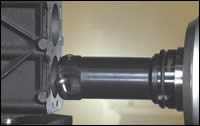Surpassing The Speed Limit In CGI
Advancing rotary-insert machining may have implications for other difficult materials as well.
Share



Hwacheon Machinery America, Inc.
Featured Content
View More




Early machining tests in compacted graphite iron (CGI) suggested that the tool technology available today would not permit a particularly high cutting speed. Much faster cutting is possible in gray iron because of the presence of sulfur. The sulfur in the metal contributes to a layer of MnS (manganese sulfide) that lubricates the tool during machining. But in CGI, there is no sulfur and therefore no capacity for MnS. Without this lubrication, the cutter in CGI today can’t hope to cut much faster than 500 sfm.
Or so it was thought. Faster cutting is indeed possible, it turns out, if the cutting action of the tool is changed.
In the last couple of years, researchers at Cincinnati Lamb (Chesterfield, Michigan) have seen dramatic improvements in milling efficiency by machining CGI with rotary-insert tooling. In a rotary-insert tool, each cutting insert rides on a bearing that leaves the insert free to spin. Using this tool design, the company has achieved speeds surpassing 3,000 sfm in CGI, using the same ceramic insert material limited to slower speeds in more conventional bodies. The proportionate improvement in tool life is just as large.
Cincinnati Lamb engineering manager George Georgiou points out that the way this tooling works departs from the way metal has been machined since the 1800s. For a standard milling tool, machining consists of overpowering the workpiece material to shear away a chip, with energy losses converted into heat. The rotary-insert tool adds the rotation of the insert to this process, so that some of the energy is spent on driving the rotation instead. Reducing the amount of heat in the cut serves to protect the tool and improve its performance.
The tool design itself is not a new technology. Rotary-insert tooling has long been available, finding a use in certain cases to extend tool life in the machining of gray iron. For the most part, however, this tool design has been a solution in search of a problem. The cost of a tool body equipped with precision bearings generally can’t justify the amount of process improvement the tool can deliver. The degree of improvement seen in CGI is an exception.
More Power
The attention that Cincinnati Lamb and other metalworking suppliers are giving to CGI directly relates to an expected increase in diesel engine production, says Mr. Georgiou. Various automakers have plans to re-introduce diesel engines to the U.S. passenger car market because of the fuel economy this engine design can deliver. CGI makes the fuel economy even better still. Compared to gray iron, an engine made from CGI can deliver the same amount of power in a smaller package.
The material’s strength makes this possible, but that same characteristic makes the material difficult to machine. Because of the high forces required, Cincinnati Lamb’s successes with cutting CGI have relied not just on the rotary-insert tooling, but also on high-power, high-rigidity machine tools.
The company’s objective today is to improve the design of the rotary-insert tooling. This is seen as the principal technical challenge to achieving a more practical CGI milling process. The bearing cartridge introduces a brand new wear component to the tool, and engineers testing new designs for this cartridge aim to achieve longer and more consistent life. At the same time, engineers are working to decrease the tool’s minimum size. Current rotary-insert tooling permits machining of bores down to 3 inches in diameter. Cincinnati Lamb hopes to reduce that limit at least to 2 inches.
One hope for all of this improvement to the rotary-insert tool is that it will lead to payoff not just in the automotive industry, but in farther removed applications as well. Says Mr. Georgiou, “There is no theoretical reason why this same concept could not be applied to titanium, Inconel, Waspalloy, metal matrix composite and just about any other material that has historically been difficult to machine.”
Related Content
How to Mitigate Chatter to Boost Machining Rates
There are usually better solutions to chatter than just reducing the feed rate. Through vibration analysis, the chatter problem can be solved, enabling much higher metal removal rates, better quality and longer tool life.
Read MoreThe Future of High Feed Milling in Modern Manufacturing
Achieve higher metal removal rates and enhanced predictability with ISCAR’s advanced high-feed milling tools — optimized for today’s competitive global market.
Read MoreHigh-Feed Machining Dominates Cutting Tool Event
At its New Product Rollout, Ingersoll showcased a number of options for high-feed machining, demonstrating the strategy’s growing footprint in the industry.
Read MoreQuick-Change Tool Heads Reduce Setup on Swiss-Type Turning Centers
This new quick-change tooling system enables shops to get more production from their Swiss turning centers through reduced tool setup time and matches the performance of a solid tool.
Read MoreRead Next
Building Out a Foundation for Student Machinists
Autodesk and Haas have teamed up to produce an introductory course for students that covers the basics of CAD, CAM and CNC while providing them with a portfolio part.
Read MoreRegistration Now Open for the Precision Machining Technology Show (PMTS) 2025
The precision machining industry’s premier event returns to Cleveland, OH, April 1-3.
Read MoreSetting Up the Building Blocks for a Digital Factory
Woodward Inc. spent over a year developing an API to connect machines to its digital factory. Caron Engineering’s MiConnect has cut most of this process while also granting the shop greater access to machine information.
Read More





































.jpg;maxWidth=300;quality=90)









